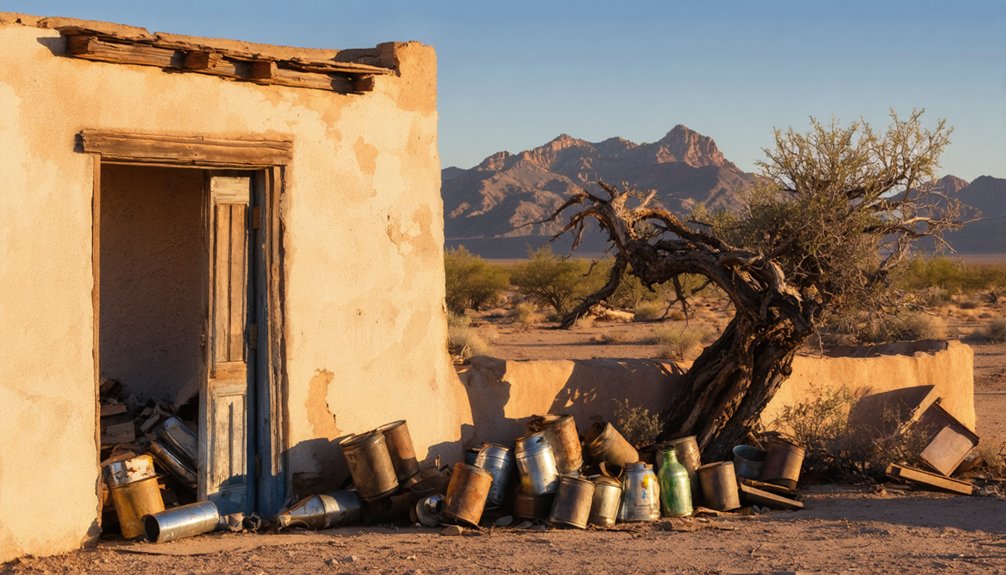Gleeson, Arizona began as a turquoise mining camp established by Chiricahua Apache tribes before transforming into a copper boomtown in the early 1900s. You’ll find the restored Gleeson Jail and remnants of buildings that once housed nearly 1,000 residents, including saloons and shops. The town survived a devastating fire in 1912 but couldn’t withstand falling copper prices, eventually emptying by 1939. These weathered structures tell a compelling frontier story beyond their crumbling walls.
Key Takeaways
- Gleeson was a prosperous copper mining town established in 1900 that thrived until the 1930s before becoming a ghost town.
- The town peaked at nearly 1,000 residents and featured saloons, shops, a hospital, and a bank during its mining heyday.
- A devastating fire in 1912 destroyed 28 buildings in Gleeson’s business district, though residents quickly rebuilt the town.
- The restored Gleeson Jail, purchased in 2008, now serves as a museum open twice monthly for visitors.
- Tourists can explore Gleeson’s mining history through self-guided walking tours along the historic Ghost Town Trail.
Apache Origins and Turquoise Trade
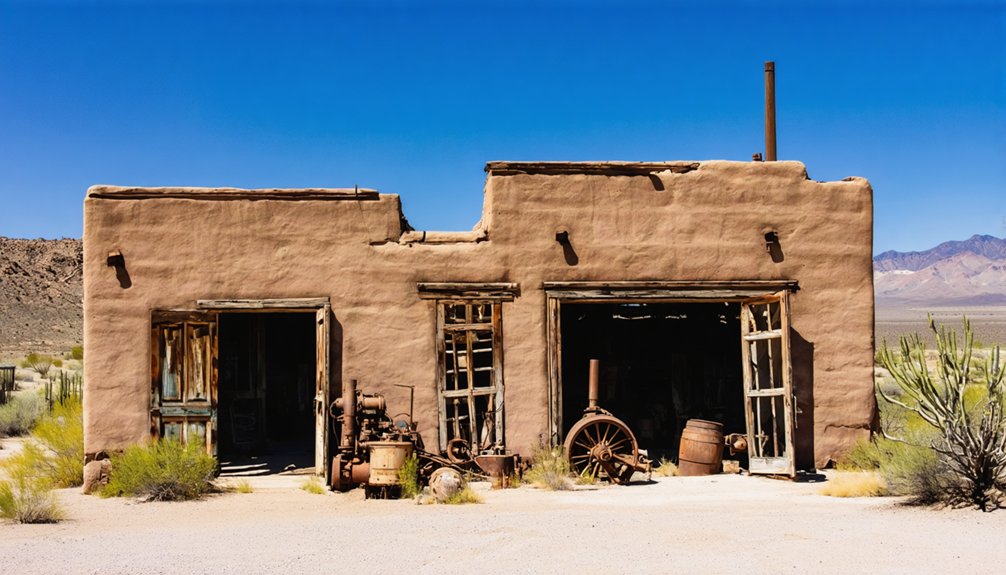
While their ancestors migrated from the frigid regions of southwestern Canada around 1000-1500 CE, the Apache people eventually made southeastern Arizona their home, bringing with them a rich cultural heritage tied to the Athabaskan language family.
The Apache migration followed the eastern Rockies southward into territories including the Chiricahua Mountains. Here, they adapted to the harsh desert climate, organizing into autonomous bands rather than centralized tribes. The Apache bands were led by informal headmen who earned their leadership positions through merit rather than inheritance. By the beginning of the 21st century, the Apache population had grown to approximately 100,000 descendants across various reservations.
Following ancient pathways along the Rockies, Apache people found their destiny in the desert, adapting through band-level organization.
You can trace their presence through the turquoise symbolism deeply embedded in their culture. This vibrant blue-green stone wasn’t merely decorative—it represented status and spiritual significance, connecting wearers to deities like Ussen.
The Apache trade networks extended throughout the Southwest, with turquoise serving as a valuable commodity that facilitated relationships with neighboring Pueblo, Hopi, and Navajo tribes.
From Mining Camp to Booming Town (1890-1910)
After prospectors discovered native copper and turquoise in the Dragoon Mountains, the modest settlement of Turquoise emerged in the 1870s, taking its name from the vibrant blue-green stone that Apache miners had extracted for generations.
The tiny mining camp gained official recognition when its post office opened in 1890, but Turquoise’s existence proved short-lived. In 1894, miner Jimmie Pearce’s gold discovery at the Commonwealth claim lured residents away, leaving Turquoise abandoned until John Gleeson’s return in 1900.
Gleeson breathed new life into the area by establishing the Copper Belle Mine, and you would’ve witnessed a transformation as the settlement relocated downhill for better water access. As with many similarly named locations, historians often need to specify this is Gleeson, Arizona to distinguish it from other references.
The boomtown quickly grew to 500 residents, developing the hallmarks of frontier life—saloons, shops, and the essential post office—with turquoise mining giving way to copper’s dominance. The town’s infrastructure expanded rapidly, with a hospital and jail remaining as visible ruins for modern-day visitors exploring the ghost town.
The Copper Belle Mine’s Transformative Impact
You’re standing on history where John Gleeson’s Copper Belle Mine transformed a modest turquoise camp into a bustling copper town after its 1896 discovery.
The mine’s impressive output—shipping $280,000 worth of ore under Gleeson’s ownership before selling for $100,000 to Shannon Copper Company—drew nearly 1,000 residents to this remote corner of Arizona. The area had previously been mined for its bright blue-green turquoise by the Chiricahua Apache tribe.
Its seven-mile network of tunnels and 400-foot shaft represent not just industrial achievement but the economic heartbeat that sustained Gleeson through its glory years, before post-WWI price drops signaled the beginning of the end. The town’s population once reached 6,000 by 1918, making Gleeson one of the significant mining communities in Arizona territory.
Frontier Fortunes Unearthed
In the sun-baked hills of southeastern Arizona, John Gleeson’s fateful discovery of copper in 1896 forever altered the destiny of what would become his namesake town.
While prospecting in the area’s established turquoise trade, his keen eye spotted copper deposits that promised far greater riches.
You can imagine Gleeson’s excitement when his Copper Belle Mine yielded ore worth $280,000 under his ownership—equivalent to millions today.
Despite primitive mining technology and the arduous 30-mile wagon hauls to Cochise, the enterprise flourished.
When Shannon Copper Company purchased the mine for $100,000 in 1901, it transformed not just Gleeson’s personal fortune but the entire region’s economic landscape.
The subsequent development of seven miles of tunnels and shafts reaching 400 feet deep exemplified frontier ingenuity against formidable odds.
Production at the mines reached its zenith during World War I when copper demand soared for military applications.
The town rose to its peak with a population of approximately 500 residents, bustling with the energy of mining prosperity before the veins eventually played out.
Copper’s Economic Legacy
The Copper Belle Mine didn’t merely extract minerals from Arizona’s rugged landscape—it extracted prosperity from the very soil of possibility.
John Gleeson’s 1900 discovery transformed a quiet outpost into a bustling community of up to 1,000 souls, with copper investments flowing as freely as hope through the desert air.
Mining innovations evolved as challenges mounted:
- Early ore processing experimented with juniper wood smelting before shipping to distant refineries
- Seven miles of underground tunnels connected multiple operations beneath the earth’s surface
- Headframes and loading conveyors stood as iron sentinels against the horizon, visible symbols of industrial ambition
When copper prices soared during World War I, so did Gleeson’s fortunes.
Yet like all frontier dreams, the prosperity lasted only as long as the ore bodies remained profitable.
Daily Life in a Frontier Mining Community
Life in Gleeson during its mining heyday revolved around the rhythms of the copper, silver, and turquoise industries that sustained its population of 500 to 1,000 residents.
You’d have lived in a modest wooden home, perhaps rebuilt after the devastating 1912 fire that destroyed 28 structures in town.
Your daily routine would’ve centered around the mines, where labor-intensive work defined the community’s purpose. The Mexican population earned higher wages for the dangerous underground mining work. The post office established in 1900 became your crucial connection to the outside world, alongside the railroad that delivered essential supplies.
Community resilience shone brightest during crises—neighbors helping neighbors rebuild after the fire, adapting to economic fluctuations.
This land, rich in minerals, had a history of indigenous mining long before settlers arrived, with Navajo and Apache peoples harvesting turquoise from the same hills you’d call home.
The Great Fire of 1912: Destruction and Resilience
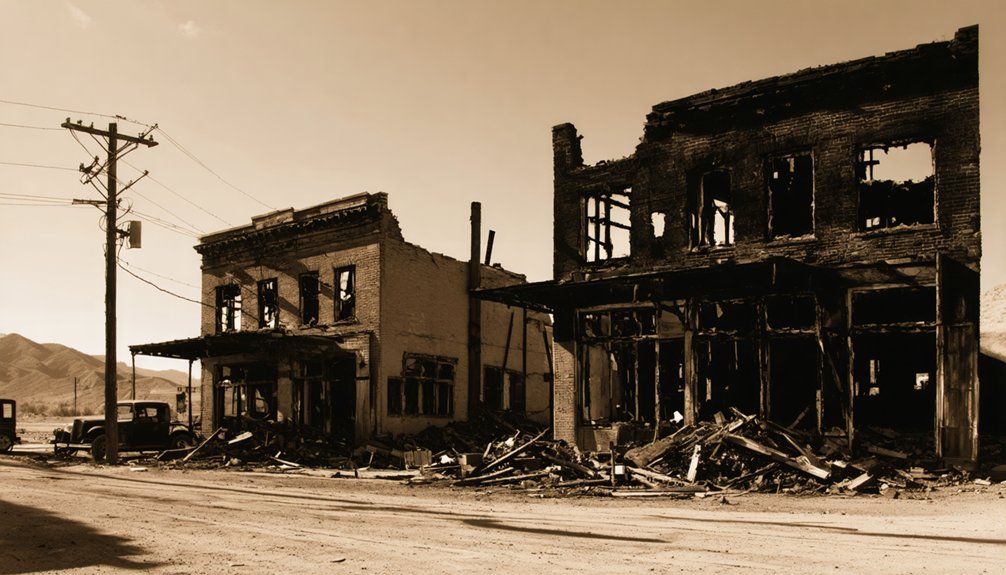
Disaster struck Gleeson on the evening of June 8, 1912, when smoke first curled from a warehouse corner where flour was stored. Without a fire department or proper fire prevention measures, the blaze quickly consumed 28 buildings in the business district, leaving only the concrete jail standing amid the devastation.
You can imagine the scene that unfolded:
- Desperate residents forming bucket brigades against the roaring flames
- Men rushing to remove barrels of gasoline and black powder from the inferno’s path
- The silhouette of the lone jail, steadfast against the destructive orange glow
Yet Gleeson’s community resilience proved remarkable. Buoyed by profitable copper mining operations and railroad access, townsfolk rebuilt with impressive speed. The restored jail now serves as a prominent museum showcasing artifacts that tell the story of this once-thriving mining community.
This rebirth, however, couldn’t protect them from the economic collapse that would eventually transform their home into the ghost town you see today.
Mining Operations and Economic Prosperity
As you walk the quiet streets of today’s Gleeson, you’d hardly imagine that copper production once flourished here, with the Copper Belle mine transforming a small turquoise camp into a bustling town of 500 residents.
Rail connections established during the early 1900s linked Gleeson’s mineral wealth to distant markets, creating a lifeline for this isolated desert community.
During World War I, extraction operations reached their zenith as miners worked tirelessly to meet the nation’s urgent demand for copper, briefly turning this dusty corner of Arizona into an essential contributor to America’s wartime industrial might.
Copper Production Peaks
While small-scale mining operations had occurred since the late 1800s, Gleeson’s copper industry truly flourished during the World War I era when global demand for the metal skyrocketed.
The Shannon Company consolidated multiple claims, expanding the underground network to over seven miles of tunnels connecting the Copper Belle and Pemberthy shafts.
When you visit today, imagine the bustling scene at its peak:
- Miners descending 400-600 feet into the earth, following veins of pyritic copper ore
- Ore carts rattling along rails to waiting wagons bound for distant smelters
- A town of 500 souls building lives around the rhythm of shift changes
The economic impact transformed Gleeson from a remote outpost into a proper town with a hospital, bank, and post office—prosperity built on copper mining that would eventually fade as accessible ore bodies depleted.
Rail Links Economy
The intricate web of mining operations that fueled Gleeson’s prosperity existed largely without the direct benefit of railroad connections that served other boomtowns of the era.
Despite these transportation challenges, the mining community thrived through innovation and determination. You’d find miners relying on wagon roads and pack animals to move copper, lead, silver, and zinc ores to distant markets.
The Mystery Tunnel exemplified their ingenuity, connecting the Silver Bill mine through 780 feet of mountain to the Mystery Mine entrance, revolutionizing ore transport after 1924.
This underground passage mitigated some railway impacts that hampered Gleeson’s growth potential. While nearby towns benefited from direct rail access, Gleeson’s economy adapted through regional networks linking to Pearce and Tombstone, creating a resilient system that supported a population of 500 during its peak years.
Wartime Extraction Boom
World War I transformed Gleeson from a modest mining settlement into a bustling industrial hub when unprecedented demand for copper ignited a remarkable extraction boom throughout the region.
The town’s population exploded to 6,000 by 1918 as wartime prosperity attracted a diverse mining workforce to the Copper Belle, Silver Bill, and Tejon operations.
You’d have witnessed:
- Miners hauling valuable ore from underground tunnels while copper prices soared to unprecedented levels
- Two-story schoolhouses, hospitals, and concrete structures rising from the ashes of the 1912 fire
- A vibrant social scene with 14 saloons and numerous businesses catering to miners’ families
The economic heartbeat of Gleeson pulsed with the rhythm of extraction, creating wealth that would tragically prove temporary when peacetime eventually returned.
Architecture and Remaining Structures
Nestled among the dusty hills of southeastern Arizona, Gleeson’s architectural remnants tell a compelling story of frontier resilience and impermanence. The 1910 reinforced concrete jail stands as the town’s most intact structure, its barred windows and open-air porch inviting you to step back in time.
Unlike its wooden counterparts that succumbed to the devastating 1912 fire, the jail’s sturdy structural materials guaranteed its survival.
As you navigate the rough, unpaved roads, you’ll encounter the Joe Bono general store, saloon with its 1982 mural, and ruins of the schoolhouse and hospital.
The visible headframe on the mountainside reminds you of Gleeson’s mining origins. These architectural styles—utilitarian yet purposeful—reflect a community that balanced frontier pragmatism with necessary amenities during the copper boom.
The Slow Fade: Decline of Gleeson’s Mining Era
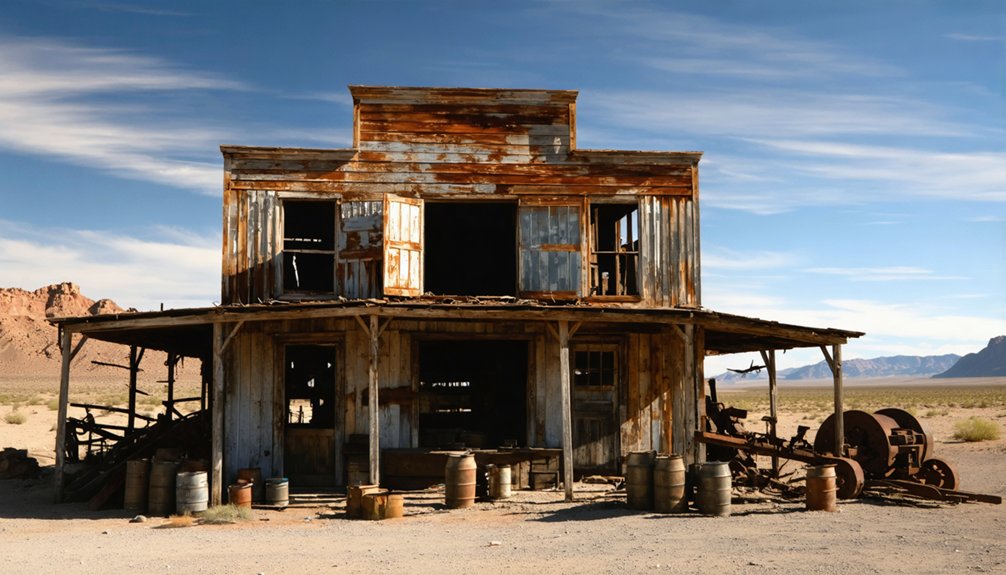
As the twentieth century progressed, Gleeson’s once-profitable mines began their inevitable decline, signaling the beginning of the end for this bustling frontier town.
The economic shifts following World War I dealt a fatal blow as metal prices plummeted and demand waned. By the 1930s, the high-grade ores that had sustained the community were depleted, leaving only low-quality deposits that couldn’t justify continued operations.
Walking through Gleeson today, you’ll notice evidence of this slow fade:
- Dismantled infrastructure where the Silver Bill mine entrance once thrived
- Underground tunnels connecting the Mystery Mine to deeper deposits—a last-ditch attempt at mine technology adaptation
- The empty post office building, abandoned in 1939 as the final residents surrendered their frontier dreams
Walking Among Ghosts: Today’s Visitor Experience
Standing silent against the stark Arizona landscape, Gleeson beckons modern explorers down a rugged dirt road where the past lingers in sun-bleached ruins.
You’ll need a high-clearance vehicle to navigate the unpaved Ghost Town Trail, about 16 miles east of Tombstone.
As you wander among weathered foundations and crumbling walls, historical reflections come naturally in this quiet, isolated setting.
The restored 1910 jail—open the first Saturday monthly—stands as the site’s centerpiece, offering the most tangible connection to former residents.
Bring water and sturdy shoes; there are no amenities here.
While some visitors report disappointment at the limited intact structures, others find ghostly encounters in the whisper of desert wind through abandoned doorways and the distant views that miners once called home.
Preservation Efforts and Historical Significance
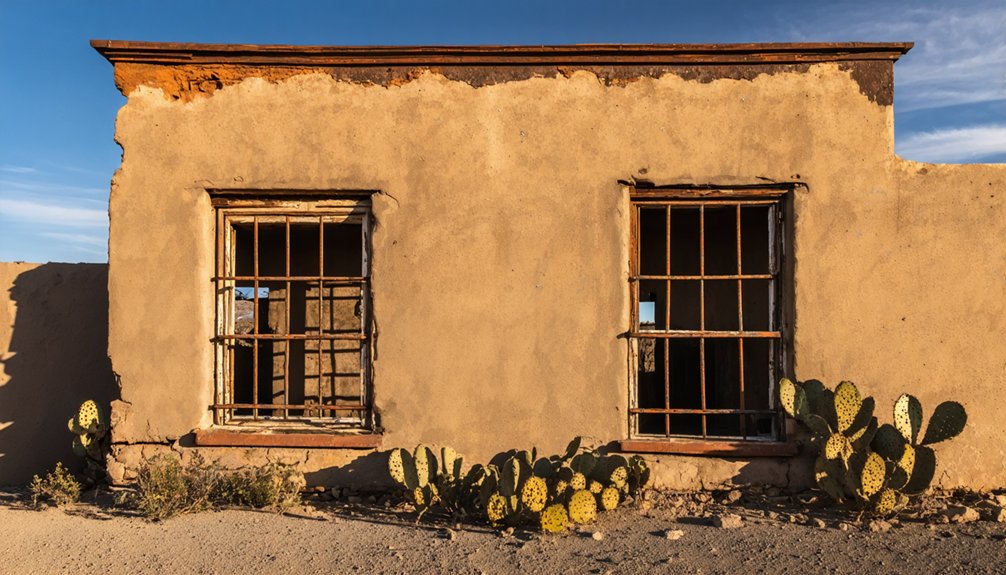
When you visit Gleeson, you’ll find the remarkably restored 1910 jail standing as proof of local preservation dedication, with original artifacts and memorabilia carefully maintained by community members.
Tours are available on the first and fourth Saturdays each month, offering you a structured glimpse into the town’s copper mining heyday when John Gleeson’s claim transformed the settlement from Turquoise to a thriving community of 500 residents.
As you explore with the provided walking map, you’ll connect with a place that witnessed centuries of turquoise mining by Native Americans before becoming an essential part of Arizona’s boom-and-bust mining heritage.
Jail Restoration Success
The crumbling Gleeson Jail, once left to deteriorate in the harsh Arizona elements for over seven decades, found new life in 2008 when local residents Tina Miller and John Wiest purchased the historic structure with a vision to restore it.
Their jail restoration project transformed this abandoned relic into a vibrant piece of living history.
When you visit today, you’ll witness:
- A meticulously reconstructed exterior matching the original 1910 design, complete with replicated “Jail” sign and date marker
- Refurbished interior spaces filled with period-appropriate artifacts and memorabilia
- Accessible grounds with parking and protective fencing that balance preservation with public access
This grassroots effort exemplifies how community engagement can salvage threatened historical landmarks.
Now open twice monthly, the jail stands as a symbol of Gleeson’s frontier spirit and resilience.
Historical Tour Opportunities
Tucked along the historic Ghost Town Trail that winds through southeastern Arizona, Gleeson offers history enthusiasts unparalleled opportunities to step back in time through carefully curated tour experiences.
You’ll discover the meticulously restored Gleeson Jail museum, now the centerpiece of community engagement efforts that preserve this mining town’s cultural heritage.
Self-guided walking tours with maps from the jail take you through remnants of frontier life—schoolhouse foundations, hospital ruins, and the cemetery that tells stories of those who sought fortune in copper and turquoise.
The town’s boom-and-bust narrative unfolds as you explore mine debris fields and faded commercial buildings. Local preservation societies have thoughtfully stabilized these structures without over-restoration, maintaining their authenticity while ensuring these tangible connections to Arizona’s mining past remain accessible for generations.
Frequently Asked Questions
Are There Any Supernatural Ghost Stories Associated With Gleeson?
Yes, you’ll discover numerous Gleeson hauntings in the old jail, schoolhouse, and hospital. Visitors report ghostly encounters with miners’ spirits, unexplained noises, apparitions, and cold spots throughout these abandoned structures.
What Happened to the Artifacts From Gleeson’s Mines?
Most mining artifacts were dismantled or salvaged after closures in the 1930s. You’ll find little formal artifact preservation now—just weathered remnants telling Gleeson’s mining history through ghost town ruins.
Is Metal Detecting or Treasure Hunting Allowed in Gleeson?
You can’t legally metal detect in Gleeson’s protected areas. BLM regulations restrict treasure hunting on archaeological sites and mining claims. Always research land status before you’re drawn to that desert freedom.
Can Visitors Stay Overnight in or Near Gleeson?
You can’t stay within Gleeson itself, but you’ll find nearby accommodations in Kentucky Camp’s rustic cabin, or explore camping options and lodging in Pearce and Tombstone, just miles away.
Were There Any Famous Outlaws Connected to Gleeson’s History?
You’ll find Santiago Garcia and Francisco Chavez among Gleeson’s famous outlaws with historic connections. They’re remembered for dramatic shootouts with local lawmen that echoed the raw freedom of Arizona’s territorial days.
References
- https://www.legendsofamerica.com/az-ghosttowntrail/
- https://www.arizonahighways.com/ghost-town-trail
- https://redhawkj6.com/gleeson-lives-on-in-stories/
- https://www.youtube.com/watch?v=N9j5N9SzQXk
- https://www.apcrp.org/GLEESON/GLEESON_Text_112708.htm
- https://westernmininghistory.com/towns/arizona/gleeson/
- https://gleesonarizona.com
- https://beyond.nvexpeditions.com/arizona/cochise/gleeson.php
- https://downbytheriverbandb.com/2014/11/23/southeast-arizona-ghost-town/
- https://www.britannica.com/topic/Apache-people
